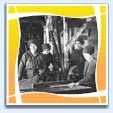 Heritage Community Foundation Presents
Heritage Community Foundation PresentsAlberta Online Encyclopedia
|
|
|
|
||||||||
 |
||||||||||
| Home | Info | Contact Us | Partners | Sitemap | ||||||||||
 |
|
|||||||||
|
Home>>
Context>> Single Women>>
Work Opportunities and Restrictions
|
||||||||||
|
Work Opportunities and Restrictions |
||||||||||

|
In the early 20th century, girls generally left home before reaching adulthood. Many women worked as live-in domestics to support their families or to save money; others migrated to the cities, where they could find employment in hotels, laundries or restaurants; and a few established their own businesses. Women who aspired and could afford to go to school trained to become teachers or nurses. They were then placed in schools or hospitals often far away from home. These jobs fitted with what people considered women's "traditional" activities. Domestics were paid to do essentially the same household tasks as married women. Chambermaids, laundrywomen and cooks specialized in roles that took on responsibilities in the home and teachers and nurses performed tasks that were seen as extensions of women's roles as mothers.
While prostitution was demoralizing to women, their success in professions such as medicine and skilled trades demonstrated capabilities comparable to that of men. Displaying their leadership, women such as the Famous 5 began to call upon other women to become involved in the community.
|
|||||||||
 |
||||||||||
 |
||||||||||
|
|
Copyright © 2004 Heritage Community Foundation All Rights Reserved | |||||||||
 |
||||||||||
††††††††††† For more on women and the vote in Canada, visit Peelís Prairie Provinces.



